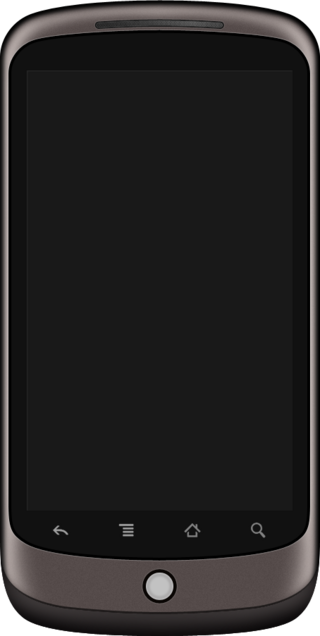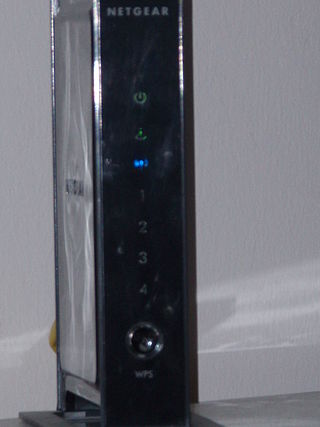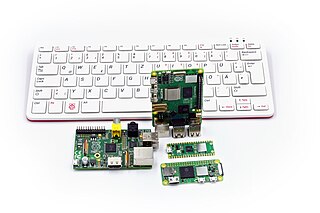
The Linksys WRT54G Wi-Fi series is a series of Wi-Fi–capable residential gateways marketed by Linksys, a subsidiary of Cisco, from 2003 until acquired by Belkin in 2013. A residential gateway connects a local area network to a wide area network.

The Nexus One is an Android smartphone designed and manufactured by HTC as Google's first Nexus smartphone. The Nexus became available on January 5, 2010, and features the ability to transcribe voice to text, an additional microphone for dynamic noise suppression, and voice guided turn-by-turn navigation to drivers.

MiFi is a brand of wireless router that acts as a mobile Wi-Fi hotspot device.
Linksys manufactures a series of network routers. Many models are shipped with Linux-based firmware and can run third-party firmware. The first model to support third-party firmware was the very popular Linksys WRT54G series.

The WNR3500L is an 802.11b/g/n Wi-Fi router created by Netgear. It was officially launched in the autumn of 2009. The WNR3500L runs open-source Linux firmware and supports the installation of third party packages such as DD-WRT and Tomato.
OpenWrt is an open-source project for embedded operating systems based on Linux, primarily used on embedded devices to route network traffic. The main components are Linux, util-linux, musl, and BusyBox. All components have been optimized to be small enough to fit into the limited storage and memory available in home routers.

Raspberry Pi is a series of small single-board computers (SBCs) developed in the United Kingdom. The original Raspberry Pi computer was developed by the Raspberry Pi Foundation in association with Broadcom. Since 2012, all Raspberry Pi products have been developed by Raspberry Pi Ltd, which began as a wholly-owned subsidiary of the Foundation.

The Nook Simple Touch is the second generation Nook e-reader developed by Barnes & Noble. It features a 600x800 E Ink screen with a touchscreen that uses a network of infrared beams slightly above the screen surface. The device also has wireless connectivity via Wi-Fi 802.11 b/g/n and a micro USB port for charging and connecting to a computer.

The Acer Iconia is a range of tablet computers from Acer Inc. of Taiwan.
The MK802 is a PC-on-a-stick produced by Rikomagic, a Chinese company using mostly two series of systems on a chip architectures:
Miracast is a wireless communications standard created by the Wi-Fi Alliance which is designed to transmit video and sound from devices to display receivers. It uses Wi-Fi Direct to create an ad hoc encrypted wireless connection and can roughly be described as "HDMI over Wi-Fi", replacing cables in favor of wireless. Miracast is utilised in many devices and is used or branded under various names by different manufacturers, including Smart View, SmartShare, screen mirroring, Cast and Connect, wireless display and screen casting.

The Nexus 6 is a phablet co-developed by Google and Motorola Mobility that runs the Android operating system. It is the successor to the Nexus 5, and the sixth smartphone in the Google Nexus series, which is a family of Android consumer devices marketed by Google and built by an original equipment manufacturer partner. The Nexus 6 and the HTC Nexus 9 served as the launch devices for Android 5.0 "Lollipop".

Intel Galileo is the first in a line of Arduino-certified development boards based on Intel x86 architecture and is designed for the maker and education communities. Intel released two versions of Galileo, referred to as Gen 1 and Gen 2. These development boards are sometimes called "Breakout boards".

Banana Pi is a line of single-board computers produced by the Chinese company Shenzhen SINOVOIP Company, its spin-off Guangdong BiPai Technology Company, and supported by Hon Hai Technology (Foxconn). Its hardware design was influenced by the Raspberry Pi, and both lines use the same 40-pin I/O connector.

The Shield Tablet, later relaunched as the Shield Tablet K1, is a gaming tablet, developed by Nvidia and released on July 29, 2014. It was Nvidia's second portable gaming device that uses Android. Compared to the Shield Portable, the controller is not permanently connected to the screen, rather it can be purchased separately. Up to four controllers can be wirelessly connected at the same time. While the Shield tablet features an 8-inch 1920×1200 pixel display, it can output 4K resolution signal to a television via HDMI.

Steam Link is a hardware and software product developed by Valve Corporation for streaming Steam content from a personal computer or Steam Machine wirelessly to a mobile device or other monitor. Steam Link was originally released as a hardware device alongside the debut of Steam Machines in November 2015. Valve discontinued the Steam Link hardware device in November 2018, in favor of supporting its software-based Steam Link application for mobile devices and smart televisions, as well as providing Steam Link as a software package for the Raspberry Pi microcomputer.

GoWarrior is an open-source and community-supported computing platform. GoWarrior is designed for new and experienced users to build electronics projects. It offers hardware, software and cloud service.
Pine Store Limited, doing business as Pine64, is a Hong Kong–based organization that designs, manufactures, and sells single-board computers, notebook computers, as well as smartwatch/smartphones. Its name was inspired by the mathematical constants π and e with a reference to 64-bit computing power.
The charts below compare hardware and firmware features in the FRITZ!Box device range.

The PinePhone is a smartphone developed by Hong Kong–based computer manufacturer Pine64, designed to provide users with full control over the device. This is achieved through the utilization of mainline Linux-based mobile operating systems, assembly of the phone using screws, and facilitating simplified disassembly for repairs and upgrades. The 2G-4GLTE modem, GPS, Wi-Fi, Bluetooth and both cameras can be physically switched off. The PinePhone ships with the Manjaro Linux operating system using the Plasma Mobile graphic interface, although other distributions can be installed by users.














